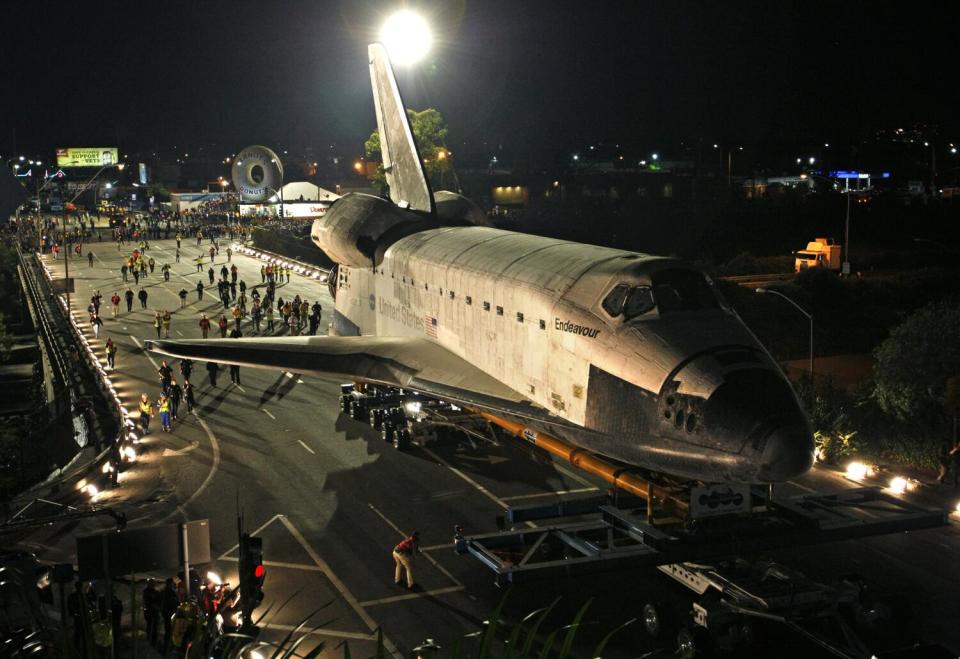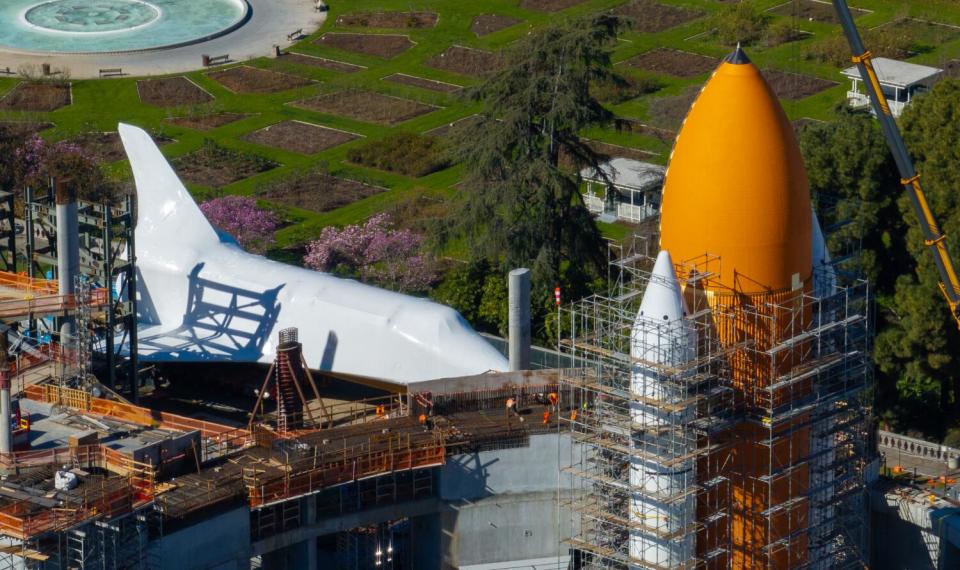Barring weather delays, the space shuttle Endeavor will make its final, historic ascent starting Monday night, a maneuver no other retired orbiter has attempted.
Plans to replace the centerpiece of the new Samuel Oschin Air and Space Center have been in the works for more than a decade. First, a pair of cranes will lift the shuttle from horizontal to vertical position; The spacecraft will be attached to a hanger, a large metal frame that will support it during movement. An 11-story crane will lift Endeavor’s tail, while a 40-story crawler crane, about the height of City Hall, will lift its nose.
Once the shuttle is pointed toward the stars, the shorter crane will be disconnected, allowing the taller crane to slowly swing the orbiter into its final position and be lowered down to be secured to the massive orange external tank. The external tank is attached to twin solid rocket boosters that connect to the base of the exhibit.
Once completed — and the rest of the museum will be built in the coming years — Los Angeles will be home to the only decommissioned space shuttle, displayed in a full-stack arrangement as if it were ready for launch.


There will be two parts to the move. The first, called “soft wife,” is scheduled to begin around 10 p.m. Monday and could last hours.
“This is part of lifting it into the building and getting it closer to the orbiter,” said Jeffrey Rudolph, president of the California Science Center.
The second part will be to “catch” Endeavor to the external tank.
“It’s extremely precise to get it in exactly the right position,” Rudolph said. “It puts all the attached hardware in the right place on the orbiter. Also, a lot of the parts that it attaches to inside the orbiter are very fragile, so they’re going to do it very slowly.”
Once that’s done, Rudolph said, everything still needs to be tightened, but the move will actually be complete. It’s believed that by Thursday everything will be “hard assembled, meaning everything will be torqued, bolted forever. And the hanger will come off and we’ll say, ‘Done,'” he said.
The program may be changed due to weather conditions, as strong winds will cause the move to be postponed.
Read more: Space shuttle Endeavor makes another journey to its final destination at a new space center
Rudolph said nothing should change from now on until the museum opens its cargo bay doors in a few years, when the Endeavor will be ready for public display.
The challenges of lifting the shuttle are different from the external tank completed earlier this month. The tank was so large that when lowered it had less than an inch of space between it and the solid rocket boosters.
Rudolph said that with the Endeavor orbiter (the last space shuttle ever built), the crew had to maneuver an object with a 78-foot wingspan and “align everything absolutely straight and neatly and extremely gently.”
“There are a few places where there are some tricky parts to lower because of the tight fit of the wings and the vertical stabilizer,” he said. “And the real challenge is to get the orbiter to the tri-port, to ‘catch it’.”
Since Endeavor is essentially a glider with a very large wingspan, it will be difficult to steer it downwards if there are strong winds.
“The wind and the blades don’t do well on the crane,” Rudolph said.
“This has never been done before with cranes, outside and on a construction site,” he said.
When the shuttle was stacked with its external tank and solid rocket boosters at the Kennedy Space Center in Florida, assembly was done at NASA’s Vehicle Assembly Building; One of the largest in the world by volume, rising more than 50 stories and armed with plenty of rockets. cranes and platforms to work on.
Read more: Mission accomplished: Space shuttle Endeavour’s giant orange fuel tank moved to monitoring point in Los Angeles


In Los Angeles, crews had to meticulously build, dismantle and remodel the scaffolding to make the correct connections.
There were also last minute changes. During the arrival of the external tank, there were times when the crew “had to rush up and dismantle and reconfigure some scaffolding pieces while we were doing the unloading,” Rudolph said.
The orbiter’s main launch is likely to last overnight. In comparison, the external tank removal took two nights. The first was delayed by wind, but crews were able to start the removal before work stopped in the middle of the morning. On the second night, the tank was lowered even lower between solid rocket boosters.
Officials hope to broadcast the latest lift live. A live broadcast to raise the external tank was canceled due to technical difficulties, and officials are trying to resolve these issues ahead of Monday’s orbital departure.
Read more: A successful launch: Space shuttle Endeavour’s rockets were deployed
A veteran of 25 space missions from 1992 to 2011, Endeavor took its last flight in 2012, ending its cross-country journey at Los Angeles International Airport before embarking on a three-day trek through city streets to the California Science Center. Endeavor was displayed in the Samuel Oschin Pavilion, a temporary hangar, for 11 years while the museum worked on a permanent home. Endeavor was removed from theaters on December 31.
Its full-stack configuration is so tall that the new museum will rise 20 stories to accommodate it.
To ensure that views were not obstructed, the building was designed with no vertical supports other than its walls. It will feature a diagonal grille developed by engineering firm Arup and covered with a stainless steel façade. Such “diagrids” were also used in other high-rise buildings, including the 46-story Hearst Tower in New York City, the iconic 40-story oval Gherkin skyscraper in London, and part of the egg-shaped London City Hall.
Once the shuttle is fully in place, the rest of the museum will be built around it. Given the construction schedule and the additional time required to install exhibits, it could be several years before it opens to the public.
Sign up for Essential California to get news, features and recommendations from the LA Times and beyond in your inbox six days a week.
This story was first published in the Los Angeles Times.